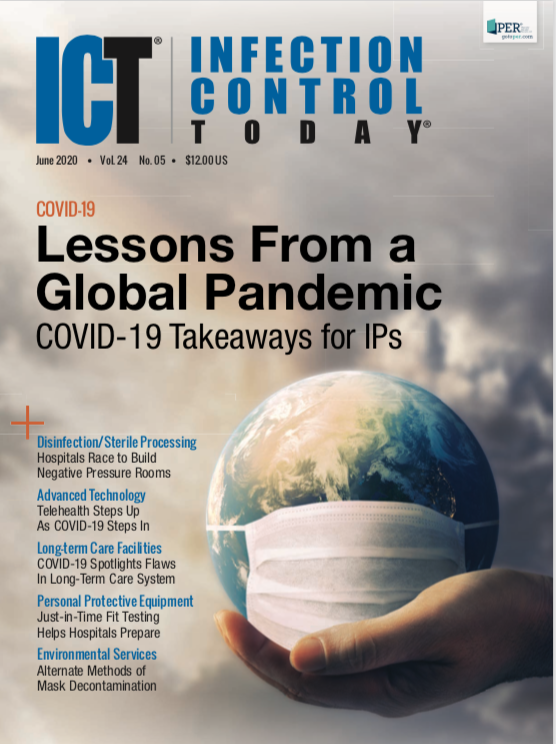What the COVID-19 Pandemic Teaches Infection Preventionists
Infection prevention sustainability isn’t easy and everyone is exhausted, but now is the time that practice makes permanent.

For many in healthcare and infection prevention, discussions regarding pandemics always land on the “it’s a matter of if, not when” statement. We often don’t truly appreciate that we’ll be living and working in the moment of a pandemic, and yet here we are. Then came SARS-CoV-2/COVID-19 and, all too suddenly it seems, the future is now. COVID-19 dramatically changed not only the lives of everyone around the world, but the very nature of infection prevention and control itself.1
Shortages of personal protective equipment (PPE) and an overwhelmed healthcare system have become the new reality. It has been challenging to strike the balance between the changing guidance and testing delays. This pandemic though, has shed light on some critical lessons and ways that hospitals and healthcare in general can better support infection prevention programs.
Perhaps one of the biggest challenges and, frankly, changes from normal practices, has been the extended use and re-use of N95 masks and other PPE. This goes against the grain for many IPs and feels awkward. Guidelines for extended/re-use have existed for a while, but IPs just never had to actually employ them. This established, but new-to-most, approach, not only impacts training and education, but also alters practices within most healthcare facilities.
Ensuring proper storage between use and emphasizing that staff not touch the front of the mask are not necessarily innate practices. Storing masks in paper bags and even establishing protocols for disinfecting measures to extend use also buck years of training and practice.
For IPs, this reveals a critical need to be flexible in times of heightened stress. Most IPs are accustomed to having to critically think in high-stress environments, but having to train other scared healthcare workers about how to do things not in the manual? Well, this makes maintaining trust and transparency a crucial goal.
During a continued stream of information overload, IPs have had to work overtime to disseminate accurate information and dispel poor information that often leads to fear. For many, this means attending huddles to not only train and education on PPE, but also answer questions staff have regarding the pandemic and the implications for their safety. Holding “open office hours” to encourage staff to stop by and talk through concerns or ask questions has been helpful in ensuring that all staff can ask no-fault questions.
COVID-19 media coverage, especially of the sensational variety, can overwhelm staff, making it so much more vital for IPs to offer sound guidance and resources. While infection prevention efforts have always involved education and communication, the current pandemic has highlighted this role even more.
One other lesson is in the role of IPs in pandemic preparedness. While this might seem like an obvious relationship, there has historically been little resources sunk into supporting and encouraging infection preventionists to allot time for preparedness. The 2014 Dallas Ebola cluster revealed the critical role of infection prevention efforts in healthcare preparedness, but also that emerging infectious diseases are something healthcare professionals need to be thinking about.2
It’s not enough to develop processes retrospectively, but rather incorporate these efforts into our continued practices. The disruption that occurs due to a lack of preparedness can be devastating to a hospital, and if we can’t maintain our continued HAI surveillance and prevention efforts during such events, IPs do patients and staff a disservice. Incorporating preparedness for these events into annual infection prevention programs and efforts is critical to adjust to not only the reality that emerging infectious disease outbreaks will continue to occur, but also that programs must adapt to meet the news of ever-changing healthcare and patient safety. Infectious diseases evolve, shouldn’t we?
In the midst of this pandemic and moving forward, it is critical that healthcare and hospital administrators work to better support their infection prevention and control (IPC) programs and the IPs that man them.
Experiences, like Ebola in 2014 and SARS-CoV in 2003, have demonstrated the ability for hospitals to amplify the spread of disease and the critical role IPC programs play in response.1 COVID-19 has been a wake-up call for public health and healthcare alike. For those leaders in healthcare, as they continue to respond to COVID-19 and even after the dust settles there are things that should be considered.
First, support IPC programs in general, expanding them so that they can address biopreparedness within the facility. Encourage efforts that expand the scope of HAI monitoring and treatment, so that they are not solely or primarily tied to those HAIs that have Medicare reimbursement implications. Train, educate, and drill staff to be able to address critical gaps in preparedness known to exist. IPs are the subject matter experts in healthcare response to biological threats and they should be empowered to better prepare the healthcare facility and staff.
Second, as IPs and other healthcare professionals will likely be dealing with COVID-19 for a while, it’s important to support IPC programs throughout this pandemic. This has been challenging for everyone and will likely be for a while. For those in infection prevention, it has been particularly difficult as changing guidance, limited PPE, fear and hysteria, and delays in testing have stressed our ability to protect patients and staff.1
Novel situations create novel problems, but erosion of trust from our frontline healthcare workers is something that should not be taken lightly. A feeling that they are not being protected or supported due to inconsistent guidance or a constant barrage of poor information, is heartbreaking. IPs need to ensure their safety and that of patients, but these are particularly challenging times.
Hospital administrators should involve infection prevention teams in higher-level response and decisions. Meet with them to address concerns and how there can be more collaborative efforts. Round on the units with them. Lastly, ensure that they get breaks.
Most of the IPs have been working around the clock since February. As impossible it may seem to part with their presence on the floor, they do all need a break from time to time, even if it’s short. It’s only through collaboration and coordination that IPs and all other healthcare professionals will be able to get through the COVID-19 pandemic and when IPs asks questions or push back against hospital administrators, those administrators need to know that IPs are not trying to be difficult, but rather they want to ensure that all things are accounted for and the hospital is providing the best possible care under historically trying circumstances.
Through continued efforts and vigilant dedication to patients and staff, IPs will help healthcare workers, patients, the nation, and the world defeat COVID-19.
Saskia v. Popescu, PhD, MPH, MA, CIC, is a hospital epidemiologist and infection preventionist. During her work as an infection preventionist, she performed surveillance for infectious diseases, preparedness, and Ebola-response practices. She holds a doctorate in biodefense from George Mason University where her research focuses on the role of infection prevention in facilitating global health security efforts. She is certified in infection control and has worked in both pediatric and adult acute care facilities.
References:
1. Centers for Disease Control and Prevention. “Coronavirus Disease 2019 (COVID-19) Cases in U.S.,” April 11, 2020. https://www.cdc.gov/coronavirus/2019-ncov/cases-updates/cases-in-us.html.
2. Morgan DJ, Braun B, Milstone AM, et al. Lessons learned from hospital Ebola preparation. Infect Control Hosp Epidemiol. 2015;36(6): 627–31. https://doi.org/10.1017/ice.2015.61.
3. Popescu, S. Roadblocks to infection prevention efforts in health care: SARS-CoV-2/COVID-19 response. Disaster Med Public Health Prep. 2020 1–3. https://doi.org/10.1017/dmp.2020.55.
4. Heinzerling A, Stuckey MJ, Scheuer T, et al. Transmission of COVID-19 to health care personnel during exposures to a hospitalized atient - Solano County, California, February 2020. MMWR. 2020;69(15): 472–76. https://doi.org/10.15585/mmwr.mm6915e5.

“Ongoing Assault”: How HHS Layoffs Have Eviscerated Infection Prevention Support Across the Nation
April 1st 2025Mass layoffs at HHS and CDC have gutted critical infection prevention programs, leaving frontline professionals overwhelmed, under-resourced, and desperate to safeguard public health.
Unraveling a Candida auris Outbreak: Infection Control Challenges in a Burn ICU
March 19th 2025A Candida auris outbreak in a burn intensive care unit (BICU) in Illinois has highlighted the persistent challenges of infection control in high-risk health care settings. Despite rigorous containment efforts, this multidrug-resistant fungal pathogen continued to spread, underscoring the need for enhanced prevention strategies, environmental monitoring, and genomic surveillance.
Unmasking Long COVID: Dr Noah Greenspan on Recovery, Research Gaps, and the Future of Treatment
March 18th 2025Dr Noah Greenspan discusses the evolving understanding of long COVID, current treatment strategies, diagnostic challenges, and the critical need for research and awareness in post-viral syndromes.